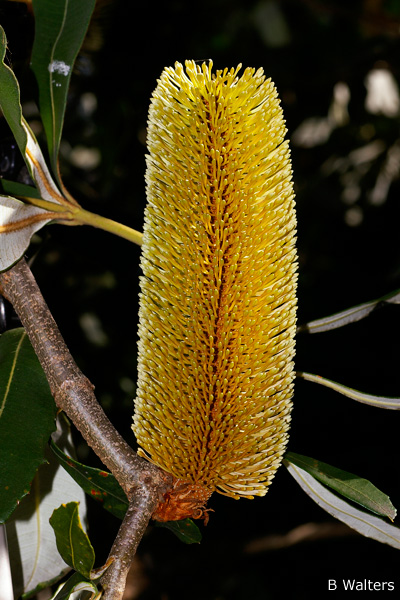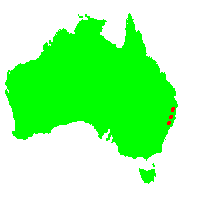General Description:
Banksia conferta is a medium to large shrub which can reach a height of 3-4 metres by a 3 metre spread. It generally has a single rough and tessellated trunk to 1 metre before branching. The species is non-lignotuberous, that is, the plants do not have a woody, underground structure that can produce new shoots. As a result they rely on seed to regenerate after fire.
The leaves are elliptical in shape, deep green on top and silvery below and usually have entire and undulating margins. The hairy new growth is attractive – being brownish or reddish in colour. The flowers occur in narrow spikes which are typically about 60 – 190 mm long and 60 mm wide. The flower buds are greenish or pink and and yellow in colour when fully open. The seeds are enclosed in follicles attached to a woody cone and are generally retained within the cone until burnt.
Previously, two subspecies were recognised; subsp. conferta (from the Glasshouse Mountains, and Lamington Plateau in Queensland and Coorabakh National Park near Taree, NSW) and subsp. penicillata (from the upper Blue Mountains, NSW). The latter is now regarded as a distinct species, Banksia penicillata. The most obvious difference between the two species is the bark – rough and tesselated on B.conferta; smooth on B.penicillata. The leaf margins of B.conferta are usually entire and undulating (usually serrated on B.penicillata).
This species has been in cultivation for only a relatively short time but is proving to be reliable in temperate and sub-tropical climates on well drained soil. The attractive foliage, new growth and unusual colors in bud are its best features horticulturally. It is best suited to full sun or dappled shade and should be useful as a densely foliaged screening plant.
Propagation from seed or cuttings is relatively easy.
* EPBC Act = Environment Protection and Biodiversity Conservation Act 1999;
ROTAP = Rare or Threatened Australian Plants (Briggs and Leigh, 1988)
For further information refer the Australian Plants at Risk page

Banksia conferta
Photo: Brian Walters
 Australian Native Plants Society (Australia)
Australian Native Plants Society (Australia)













